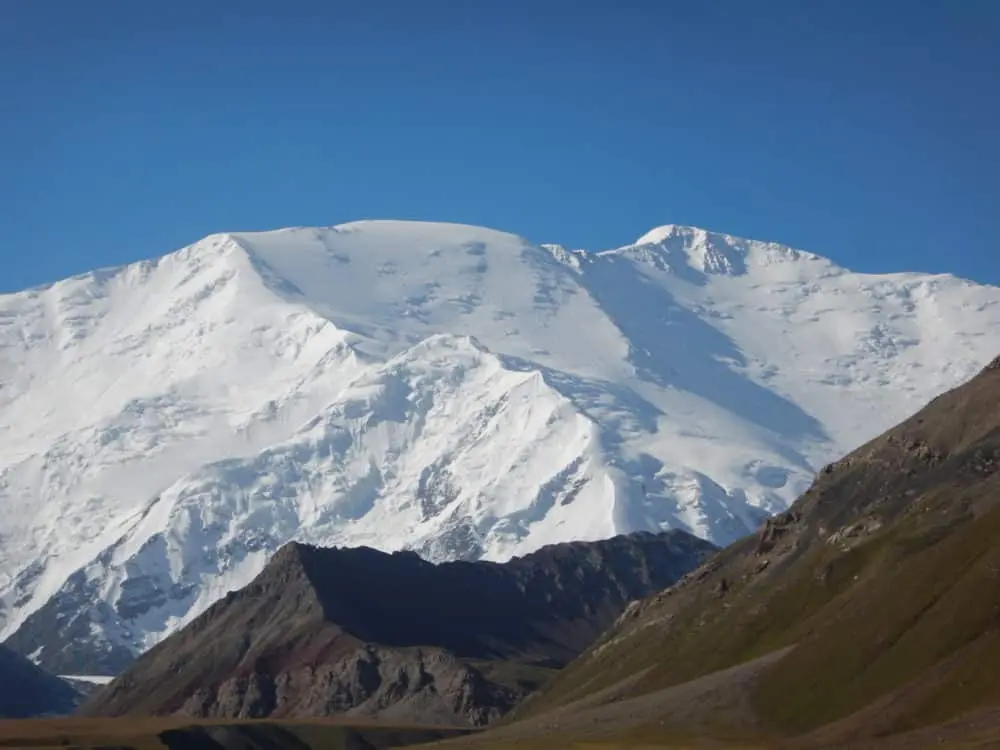One of the notable peaks in the Pamir mountain range in Central Asia. Standing at an elevation of around 7,134 meters (23,406 feet), it’s considered one of the highest summits in this range and is a popular destination for experienced mountaineers.
Lenin Peak, previously known as Mount Kaufmann, was named after the Russian revolutionary Vladimir Lenin. It’s located on the border of Kyrgyzstan and Tajikistan and is part of the Trans-Alay Range in the Pamirs. The peak is known for its relatively accessible routes, which make it a common choice for climbers aiming to conquer a 7,000-meter summit.
The mountain offers several climbing routes of varying difficulty, which range from the technically challenging to more manageable ascents suitable for those with solid mountaineering skills. The most common routes include the Normal Route from the north and the Razdelnaya Route from the south. These paths typically involve glacier travel, ice climbing, and varying degrees of technical challenges.
The best time for climbing Lenin Peak is generally from June to August when the weather conditions are more favorable, but even then, the weather can be unpredictable, and climbers need to be well-prepared for extreme conditions.
Due to its altitude and the challenges it presents, climbing Lenin Peak requires proper acclimatization, physical fitness, mountaineering experience, and appropriate gear. Many climbers choose to acclimatize at the base camp before attempting the summit to reduce the risk of altitude sickness and ensure a better chance of success.
The stunning views and the challenging yet rewarding nature of Lenin Peak attract mountaineers from around the world, adding to its allure as a prominent peak in the region.
What’s the average climbing duration?
The average climbing duration for Lenin Peak can vary significantly based on several factors, including the chosen route, weather conditions, acclimatization, and the climber’s experience. However, a typical expedition usually lasts between three to four weeks.
Here’s a general breakdown:
Acclimatization:
Many climbers spend several days or even a couple of weeks just for acclimatization. This involves gradually ascending to higher altitudes, spending time at various camps to allow the body to adjust to the reduced oxygen levels.
Climbing Period:
The actual climbing period for the ascent and descent of the peak can take around 10-14 days, depending on the chosen route and weather conditions. This duration includes establishing higher camps, making the summit push, and returning to base camp.
Variable Factors:
Weather plays a significant role. Poor weather might force climbers to wait at camps, extending the overall duration of the expedition. Additionally, the physical condition of the climbers, unexpected challenges on the route, and the need for rest days also impact the overall duration.
Overall, a successful climb typically involves allowing for enough time to acclimatize, ascend, and descend safely. Therefore, most expeditions plan for around three to four weeks to account for these various factors and to ensure a higher chance of reaching the summit safely.
What gear is essential for climbing?
Climbing Lenin Peak demands a comprehensive set of gear due to the high-altitude conditions and technical challenges. Here’s a general list of essential gear for such an expedition:
Clothing:
1.Base Layers:Moisture-wicking, breathable base layers.
2. Insulating Layers: Fleece jackets or down jackets for warmth.
3. Outer Shell: Waterproof, windproof jacket and pants.
4. Headgear: Climbing helmet, beanie, balaclava, and goggles for eye protection.
5. Gloves: Liner gloves and heavy-duty, waterproof gloves.
Footwear:
1.Mountaineering Boots: Sturdy, insulated boots suitable for crampons.
2. Crampons:Compatible with your boots for glacier and ice travel.
Climbing Equipment:
1. Harness:Comfortable, adjustable harness for safety.
2. Ropes: Static and dynamic ropes, depending on the route and team size.
3. Ice Axe and Ice Tools: Essential for glacier travel and ice climbing.
4. Carabiners, Pulleys, and Ascenders: Used for anchoring, safety, and ascending ropes.
5. Helmet: Protects against falling debris.
Safety Equipment:
1. Avalanche Gear:Depending on the route and conditions.
2. First Aid Kit: Including altitude sickness medication, wound care, etc.
3.Communication: Satellite phone or emergency communication device.
4. Navigation Tools:Map, compass, or GPS.
Camping Gear:
1. Tent: High-altitude, weather-resistant tent.
2. Sleeping Bag: Rated for extremely low temperatures.
3.Sleeping Pad: Provides insulation from the ground.
4. Stove and Fuel: High-altitude stove for cooking.
Miscellaneous:
1. Backpack: Large enough for gear, but not too bulky for climbing.
2. Sun Protection: Sunscreen, lip balm, and sunglasses.
3. Hydration System: Water bottles or a hydration pack.
.Food:High-energy, non-perishable food suitable for extreme conditions.
These items form a basic framework, but specific gear requirements can vary based on individual preferences, the chosen route, and the duration of the expedition. It’s crucial to invest in high-quality, reliable gear that’s suitable for extreme weather and altitude conditions.


